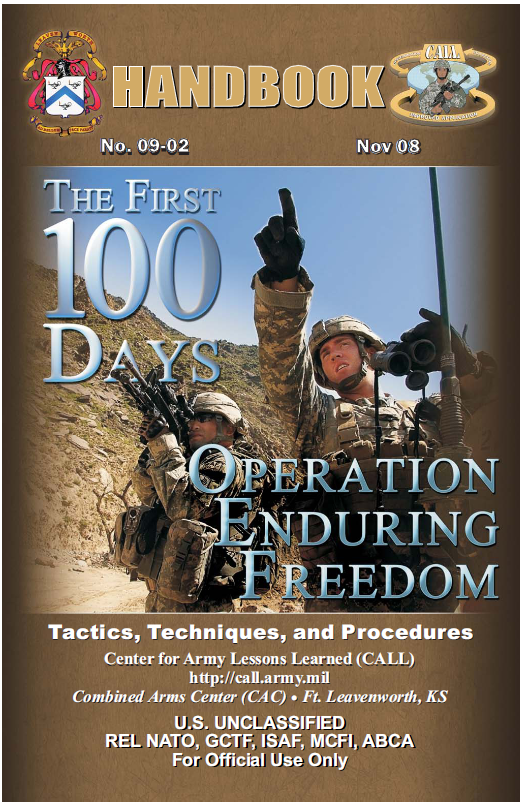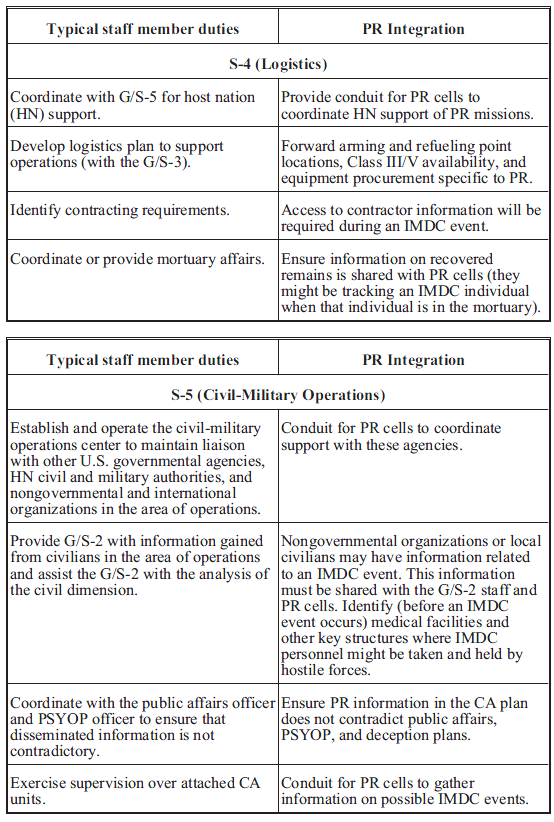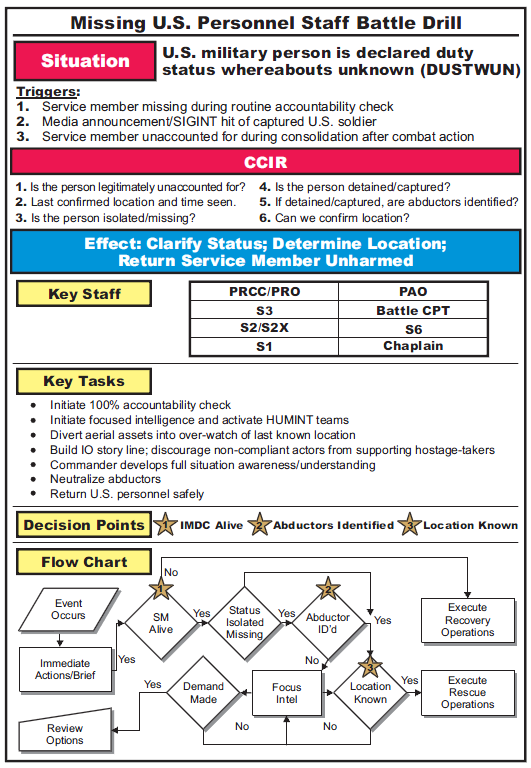 FIRST 100 DAYS OEF HANDBOOK
FIRST 100 DAYS OEF HANDBOOK
- 128 pages
- For Official Use Only
- REL NATO, GCTF, ISAF, MCFI,ABCA
- November 2008
Section I: Predeployment Training
“Predeployment training gave everyone confidence in our battle drills. No one had to think about what needed to be done.”
Staff Sergeant, Infantry Squad LeaderPredeployment training is the most important factor in increasing your ability to survive in combat. Do not take your training for granted. Take advantage of any opportunity to do additional training. Training must be realistic. Look to the combat veterans in your unit as a way of measuring the realism of the training. Soldiers/leaders with combat experience should conduct training for units readying for combat. Predeployment training is important:
• Predeployment training is your opportunity to build combat skills.
• Repeated training builds “muscle memory” so critical in reacting
correctly the first time you experience combat.• You and your fellow Soldiers (your “battle buddies”) can solidify as a
team.• You get comfortable with carrying a weapon with live ammunition and
learn “muzzle awareness.”Critical Training
Improvised explosive device-defeat (IEDD)
Improvised explosive devices (IEDs) represent a significant threat to U.S. forces
in the Afghan theater of operations; however with the right training and proper
practices, you can significantly reduce the threat of an IED attack:• Get the latest enemy techniques and tactics for IEDs.
• Concentrate on IEDD techniques and practices until they become second
nature.• Use every opportunity to practice the IEDD techniques you learn in
training.Basic rifle marksmanship
You must be able to maintain muzzle awareness, trigger safety, and weapons status
on your own:• Zero your weapon both the back up iron sights and combat optics (M68
close combat optics “red dot” and advanced combat optical gun sight).• Fire as many rounds as necessary until you are confident in your ability to
hit your intended target.…
Section IV: Battle Buddy
“We had the same procedures and they were people I could trust because I
knew how they did during the training. Most of them were like brothers to
me and still are, and I think that is important.”
Specialist, Combat EngineerRemember the following; they are not cliches:
• Soldiers in combat fight, sacrifice, and survive because of their loyalty to
their fellow Soldiers.• Team-building begins with your unit; train with the Soldiers you will go
to combat with.• Spend time getting to know your fellow Soldiers; know them as a person first and then as a Soldier.
• Build trust with the Soldiers and leaders in your unit.
• Build the expectation that everyone will know his job.
• Train as a team, so that you can react to combat without hesitation.
• Train to the point that you know exactly how everyone in the team will
respond in any given situation.…
Section V: Every Soldier is a Sensor
“Soldiers must understand what is normal in everyday life. This
understanding will better enable them to distinguish dangerous situations
from normal situations.”
SFC, Scout Platoon SergeantEvery Soldier is a Sensor (ES2)
Every Soldier, regardless of military occupational specialty or duty position, has a
part to play in gathering information for use by intelligence analysts. In the current
operating environment there is abundant information to be gathered among the
civilian population on the street and in the villages, and that is where the individual
Soldier has the edge over technical means. The Army gave this concept a name:“Every Soldier is a Sensor.”
The ES2 concept requires you to be competent in two broad areas:
• You must actively search for details related to the commander’s critical
information requirements:º Be on the lookout for specific people, vehicles of a certain
description or type, particular items of weaponry or equipment,
and patterns of enemy or civilian behavior.º Before you drive or walk out into the area of operations, your
squad or platoon leadership should tell you exactly what to “be on
the lookout for.” These are referred to as BOLO items.• You must competently report experiences, perceptions, and judgments in
a concise, accurate manner:º Your leaders should tell you what to bring to their immediate
attention (as soon as you see or hear it) and what can be reported
later.º The SALUTE report is still the standard:
Size: How many are there?
Activity: What are they doing?
Location: Where are they (grid coordinates)?
Uniform: What are they wearing?
Time: When did you see this activity?
Equipment: What are they carrying or driving?
…
Section II: Adaptability
“The first 100 days will always be the hardest for survivability. The enemy
is testing your unit, looking for strengths and weaknesses, and trying to
scare you a little bit.”
1st Lieutenant, Service Support Platoon Leader
Enemy AdaptabilityThe enemy is intelligent, crafty, and adaptive. They watch what you do and
identify habits, patterns, and routines. The enemy studies how you react in a
situation, such as your improvised explosive device-defeat practices. He will even
contrive false circumstances in order to watch and learn the ways in which friendly
forces react. The enemy uses this knowledge to alter his attack tactics, techniques,
and procedures and exploit your weaknesses.The enemy documents many of his attacks on video for use both as a recruiting
tool and to dissect the attack (learn what worked and what did not work), and then
changes his tactics accordingly.The best strategy for countering the enemy’s efforts is to be constantly vigilant for
signs of enemy observation, while taking steps to vary the manner in which you
perform everyday actions. Watch for any civilian that seems to have an
unwarranted interest in what you are doing when patrolling and convoying.
It is natural to follow a routine for conducting daily tasks. Soldiers must monitor
their personal habits and those of their team when working “outside the wire.”
Remember that the enemy will spend days and weeks studying you and your unit in
an attempt to template your activities. He will use this template to develop a plan
for attacking you. Even small variations in activity can disrupt a planned enemy
attack. Imagine an enemy’s dismay when the very day he is ready, your patrol
departs the gate 45 minutes early and turns in the opposite direction.
Learn from every mission:• Seek lessons from other units in your tactical area of operations. Your unit can take advantage of what worked for them and avoid the pitfalls
they encountered.• Conduct a personal after-action review on your own actions:
º How well did you execute your mission tasks?
º What were the shortcomings in your personal performance and
the performance of your unit?º How will you make changes to correct the problem?
• Train and drill your unit to correct known problems before the next
mission.…
Section IX: Biometrics at the Company Level
What is Biometrics?
Biometrics is a method of measuring an individual’s physiological and behavioral
characteristics in order to establish that individual’s identity with certitude.
Biometrics is part of the Department of Defense (DOD) effort to gain “identity
dominance” in the counterinsurgency operational environment.Identity dominance occurs when the DOD can identify, track, and further exploit
persons of intelligence and national security interest despite their efforts to hide
within a population. With identity dominance, the DOD can link an enemy
combatant or similar national security threat to his previously used identities and
past activities.Biometrics captures physiological characteristics (iris, fingerprints, face), along
with other physical features (height, weight, hair and eye color, and gender) and
tags the data to an individual. The biometric data is then archived to a common
database for future reference.Information gathered during military operations is processed and compared to
biometric information in the database. The resulting intelligence information is
provided to the Soldier conducting the operation. Additionally, biometrics
collection supports establishing overall census data of a given population area.
Biometrics is becoming part of many operational missions. The Army is fielding
select biometric collection systems down to the squad level. Leaders and Soldiers
must have biometric training prior to deploying into combat. This training should
begin at home station and continue with collective training events at a combat
training center or mobilization station.Leaders must understand how to integrate biometrics into their mission planning
and execution. Platoon and company leadership must have situational
understanding on biometric capabilities to ensure their Soldiers can use this
equipment.Company leaders will use two biometric systems: the Biometric Automated
Toolset (BAT) and Handheld Interagency Identity Detection Equipment (HIIDE).
BAT is generally employed as a company- and above-level biometrics collection,
database and repository tool. HIIDE collects biometric data on individuals during
tactical operations. HIIDE has a database that can store “watch lists” and
information on persons of interest (downloaded from the BAT). Information stored
in HIIDE can provide Soldiers the necessary information to determine whether an
individual should be detained or released.At the end of a mission, the Soldier uploads data collected in HIIDE to the BAT
system. The BAT system then moves this data to regional and national databases
for sharing, storing, and matching.Biometrics supports the mission in the following ways:
• The BAT system can confirm a person of interest’s identity by
performing a search against a local, regional, or national database. The
enemy can easily alter or falsify paper documents and identification
cards; however, biometrics identification is unique to each individual.• Whether Soldiers are on patrol, conducting a raid, operating a checkpoint,
screening a local national for a job, or conducting operations to confirm a
high value target (HVT), a biometric device enables them to know if the
person in front of them is who he claims to be.• Biometrics positively identifies persons of interest, insurgents, terrorists
and others who would harm forces and facilities.• Force protection relies on the accurate identification of individuals.
Biometric devices will help to save lives.
Planning considerations for company leaders:• The company must have at least two trained BAT operators and eight
HIIDE trained operators. HIIDE is a train the trainer (T3) device
requiring limited, but focused operator-level training.• The BAT database is classified Secret/No Foreign Disclosure.
Commanders must be aware of this and ensure operations security
considerations are followed.• HIIDE requires minimal logistical and maintenance support. HIIDE
requires two internal batteries and a spare that can provide up to six hours
of operation.• Operators must upload HIIDE collected biometric files and tracking
reports to the BAT to ensure conversion to the BAT database.• Data transfer between BAT to HIIDE and HIIDE to BAT must be well
planned. When operating at remote sites where only HIIDE is available,
transportation assets may be required to enable download and upload of
the most current information.…
…
Annex B
How to Face the Injured and Dead
In combat or disaster situations, you may see, hear, smell, and perhaps have to
handle badly injured and dead men, women, and children of all ages.You may be struck with mixed feelings of pity, horror, revulsion, and anger at the
senselessness or malice of the event. It is even more painful when a victim reminds
you of someone you love or yourself. You may feel guilty for failing to prevent it,
for surviving it, or for not helping enough. These reactions are normal, a part of
being human. You may blame yourself or the United States.Keep in mind that these feelings are honorable and confirm your humanity. At
times, however, you may feel emotionally numb and may use “graveyard humor”
to make the suffering and deaths seem less terrible. Whatever you feel, remember
that the mission must continue.What follows are lessons learned from people who have faced such horrible
experiences. These tips can help you conduct the mission and live with the
memories without being haunted by them.1. Remember the larger purpose of what you must do. You are showing care,
giving hope, and preventing disease for the living. You are recovering the bodies
for registrations and respectful burial.2. Limit exposure to the stimuli: Do not sightsee; use screens, poncho curtains,
partitions, covers, body bags, and barriers to keep away anyone who does not need
to see.3. Wear gloves and disposable uniforms if available.
4. Mask odors with disinfectants, deodorants, or air fresheners. Save perfumes or
aftershaves for afterwards. Do not be surprised when odors trigger memories.5. Be compassionate, but avoid focusing on any individual victims, especially
those you most identify with. Do not focus on personal effects.6. Personnel who did not search the body should examine any materials collected
for identification of the body or intelligence.7. Remind yourself the body is not “the person,” just the remains.
8. Keep humor alive, even “graveyard humor” with buddies who understand it, but
do not get too graphic or too personal (do not pick on each other).9. Do not desecrate or steal from the victims; those actions are punishable under
the Uniform Code of Military Justice.10. Ask unit or local ministers to conduct memorial services and perform personal
religious rituals as appropriate.11. Schedule frequent breaks; maintain hygiene, drink plenty of fluids, and eat good
food. Command should arrange facilities for washing hands and face, followed later
by showers and fresh clothes.12. Have your team get together for mutual support and encouragement.
Acknowledge the horrible aspects of the situation but do not dwell on detailed
memories.13. Help buddies or subordinates in distress by being a good listener. Do not jump
in with “off the shelf” answers. Do not mistake feelings as weakness; communicate
that these feelings are normal and honorable. Remind subordinates that the mission
must go on, and the team needs everyone.14. If forewarned of the mission, prepare yourself for what you will see and do and
take the supplies and equipment mentioned in paragraphs 2, 3, and 4.15. After the mission is complete, do not feel guilty about distancing yourself
mentally from the suffering or tragic deaths of individuals.16. Do not be disheartened by horrible dreams, feeling tense, or intrusive memories.
These reactions are normal, and it is better to acknowledge them now than to
suppress them. Share these reactions with your buddies, and keep positive humor
alive.17. One to three days after the exposure to a stressful event, participate in a critical
event debriefing with trained people from your supporting unit ministry and/or
behavioral health/combat stress control team.These techniques and coping skills cannot make a horrible and tragic event
acceptable or easy, but they can help you and your teammates better cope with the
stress in order to complete the mission. Be proud of what you have done, and use
these lessons learned to take care of yourself, your buddies, and your family when
you get home.


